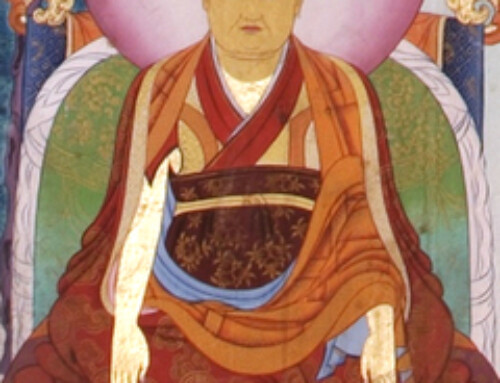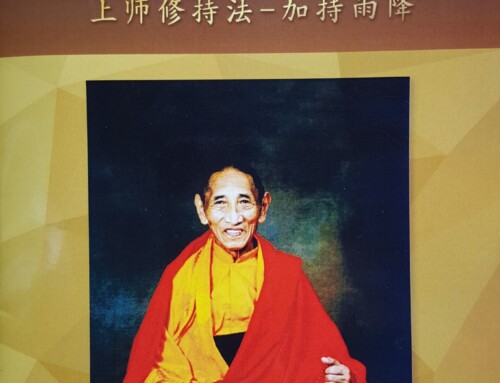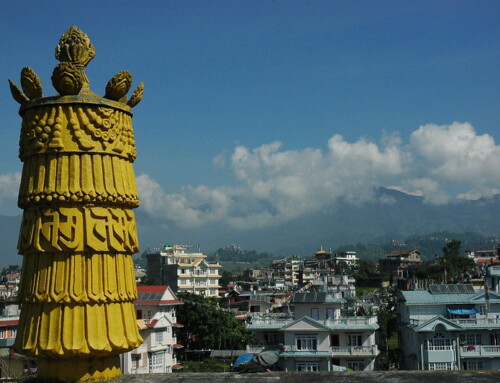Reflections on Mahamudra’s Four Stages of Yoga!
What is called Mahamudra in Sanskrit is called Chag-gya Chen-po in Tibetan, Great Seal in English. Maha means “great” and mudra means “seal.” The overall sense of the meaning is that all of the phenomena of samsara and nirvana and the path of spiritual practice never pass outside of the seal, or fence, of being the sphere of empty primordial mind-itself1. There are several divisions of Mahamudra, such as base Mahamudra, path Mahamudra, and resultant Mahamudra. In Sutras such as the Perfection of Wisdom Sutras, base Mahamudra is referred to with terms such as Dharmakaya Tathagatagarbha, the Buddha Nature which is present in all living beings, and in the context of tantra it is called ‘primordially present spontaneously born wisdom’. There are many other different terms with same meaning. To manifest the Mahamudra Buddha Nature that is already present within us at the base, we persevere in the practice of path Mahamudra and, in dependence upon path Mahamudra’s Four Stages of Yoga, ultimately, resultant Mahamudra manifests.
One-Pointedness!
The Four Stages of Yoga of Mahamudra are One-pointedness, Freedom From Elaboration, One Taste, and No Meditation. As for the first yoga, One-pointedness, there are various levels, beginning, intermediate, and advanced, but to summarize, there are essential instructions for the body and essential instructions for the mind. First, the instructions for the body.
It is very important for the body to sit straight upright. If the body is straight, the psychic channels are straight; if the channels are straight the energy that moves in them flows straight; and if the energy flows straight the mind settles itself. Energy is the horse of the mind so it is very important that the breath be left natural, as it is. For the energies to flow smoothly, the channels in which they move must be straight, not crooked. For the channels to be straight, the basis upon which the channels rely, the body, must be straight.
For beginners it is important to meditate many times a day in short sessions. If a beginner meditates too long it can cause eye strain. It can make the mind or physical elements uncomfortable with headache or other problems. Some beginners say, ‘Whenever I meditate my mind is like a monkey jumping to anything it thinks of!’ This, however, is just a sign of not having really checked the mind before, and not a case of having a new increase of thought. You must begin where you are, that is, by meditating on that mind that has so many thoughts of everything. To begin to stabilize attention, a beginner may also place the form of a Buddha, a flower, a candle, etc. in front of their eyes, and try to keep mental consciousness, by way ofvisual consciousness, resting stably on the object. Some do shamata meditation by counting the breath, while others meditate on the form of a Buddha in the space before them.
Mind’s essential nature
In traditions such as Kagyu and Nyingma the path of shamata uses the method of abiding single pointedly on the focal object of the mind itself. We develop shamata using the three-fold stillness, movement, awareness method. Stillness, or abiding, means the mind stays single-pointedly on its object, mind-itself, without any interruption by thought. Movement occurs when, unable to remain on its object for long, in the second moment, a thought intervenes and moves to another object. Awareness means thinking, in the next moment, the third moment, ‘My mind has moved.’ Awareness has recognized it. In any case, stillness, movement, and awareness are all one and the same mind, but the three terms are used from the point of view of their different functions.
In the beginning there is a tremendous amount of movement, with thoughts running like a waterfall down a steep mountain. Gradually, if you meditate with persistence, movement of thought will diminish somewhat and be more like a river slowly flowing through a valley. Awareness can recognize movement right when it occurs. Finally, movement does not disturb stillness during meditation. Like snow falling on a hot stone, as awareness recognizes movement, movement’s dissolution becomes simultaneous with its arising. Ultimately, as shamata is attained, meditation becomes like the ocean. Then, during any activity outside of meditation, whether eating, sleeping, sitting, walking, etc. meditation continues naturally, just by not losing mindful awareness.
Thus, freed from gross manifestations of delusions of attachment, aversion, ignorance, etc., peeling thoughts away from the mind like the layers of an onion, we must distinguish the awareness of mind-itself. There are many types of mind states, virtuous, non-virtuous, neutral, yet here, since compulsive discursive thought is the root of deluded beings’ ignorance, we seek to see that which is free of it, like the heart of the onion, the deep timeless awareness, like stainless space, that has never been tainted by delusion.
Freedom From Elaboration!
Like One-pointedness, Freedom From Elaboration also has beginning, intermediate, and advanced levels, but to summarize it briefly, in dependence upon the path of shamata, as just described, when meditating you become free of being glad when the mind is still or upset when the mind is in movement, and as One-pointedness is attained, there are experiences of bliss, clarity, and non-conceptuality. Now, in Freedom From Elaboration, these experiences are released, as all minds of subject- object duality are purified, cease, in their own places, and the essence of awareness
Shamata, in Sanskrit, is meditation in which the mind calmly abides, single pointedly placed upon an object. Once accomplished, it is the full development of balanced concentration, blissful and effortless, providing the best basis for further meditation, stable psychic abilities, etc. The first yoga, One Pointedness, is primarily shamata meditation at the beginning level, while at the intermediate level, it is a union of both shamata and vipasyana, penetrative insight meditation, while at the advanced level it becomes fully qualified union of shamata and vipasyana, as the trainee is introduced to and meditates upon the essential nature of their own mind.
During meditative equipoise, the mind is freed of all elaboration such as the mental factor of intellectually contrived delusions. In the view of Freedom From Elaboration, the essence of awareness is very clearly seen. Like seeing the crescent moon on its third day of waxing, it is the beginning of the manifestation of the essence of our awareness, the base Mahamudra which has been forever intrinsic to us. Signs of attainment of this path in terms of realized qualities, are faith that ones root Guru is an actual Buddha, with spontaneous gratitude, reverence, and devotion, and genuine spontaneous compassion for all beings of the six realms of samsara. Your mind is freed from the snare of doubt. Firmly and one-pointedly decided, you feel determined and capable of meditating even up to death, if necessary, for attainment of realization. As with One- Pointedness, there is no need to calculate stillness, movement, and awareness because, leaving whatever thought arises unaltered, just as it is, you are introduced to knowing that grasping thought is pure rigpa-awareness. Arising and dissolving of thought becomes simultaneous, like snow falling on hot stone.
One Taste!
This also has beginning, intermediate, and advanced levels, but to summarize, here we realize that all phenomena that appear and exist are unborn in a great state of equality. Body, mind, and appearances, all inseparable, you realize them to be of one taste within the expanse of your own pure rigpa-awareness essential nature. You are freed from the pitfall of the eight mundane concerns. Dualistic thought is purified right where it arises. Craving for pleasurable objects of the six consciousnesses is released right where it arises. There is no division between being in and out of meditative equipoise.
No Meditation!
Although there are many divisions such as small, middling, and great, to summarize, all phenomena of samsara, nirvana, and the path, converge like a hundred rivers under a single bridge. Having perfected your essential nature of rigpa-awareness,
Here, and below, translating the Tibetan, mos gus, the term often used is ‘devotion.’ As this is a bit general and unfamiliar to some foreigners, the translation here breaks it down into its component meanings of, one, being deeply convinced and reverential that the Guru is an actual Buddha for you, and two, being tremendously grateful that the Guru is willing to guide and care for you. There are many shades of meaning to the term, conviction, respect, reverence, admiration, awe, gratitude, all of which the term ‘devotion’ is intended to describe, and the translation uses the word devotion, as well as ‘conviction and gratitude’ again below.
deva, demigod, human, animal, preta, and hell realms
being overly pleased or displeased because of gain, loss, praise, blame, good news, bad news, feeling good, or feeling bad.
visual, audio, olfactory, gustatory, tactile, and mental consciousnesses, the five sense consciousnesses and one mental consciousness.
there is no object of meditation and no meditation.
At this point the subtle delusions, obstacles to omniscience, are eliminated and you see all phenomena of samsara and nirvana without obscuration, as clearly as something resting in the palm of your hand. Like not finding ordinary rocks when you go to an island where everything is gold, in that King of the Ultimate, empty pure awareness, at that royal state of the Dharmakaya of No meditation, even if you look for delusions there are none to be found. There is no difference between being in or out of meditation. Ultimately manifesting the resultant four bodies and transcendent wisdom, there is no difference between samsara and nirvana, buddhas and sentient beings. You are freed of all danger of the three realms of samsara, and ultimately attain the state of a Buddha.
At the stage of One-pointedness, if meditation is prolonged through a union of shamata and vipasyana you develop special experiences of bliss, clarity, and non- conceptuality, and the foundation is set for your mind to be able to reach deep awareness. The appearance of these various experience, however, are like inner clouds and it is a mistake to think that they are actual realizations; we must differentiate between such experiences and realization. Realization is beyond the movement of mind and mental factors and is just the sphere of awareness of the deep insight of our own pure awareness, like space free of clouds. As said in the praise of the Mother Perfection of Wisdom,
Beyond speech, thought, expression, wisdom gone beyond,! Unborn, unceasing, with a nature like space,
Discerning transcendent wisdom’s own sphere of awareness,! Homage to the Mother of the three times’ Buddhas.
When you experience the essential nature of your own awareness there is a very special realization of bliss that is beyond thought or expression. Amidst constricting, deluded mental factors, pure wisdom awareness is like a jewel. It is like a beggar finding in a garbage heap a jewel that can fulfill all wishes. There is born a special joy unlike anything ever felt before. This is a sign of the development of realization.
Clearing Obstacles and Boosting Practice!
The method to clear obstacles and boost practice in our own system, the peerless Kagyu tradition, is devotion to the Guru, nothing else. Just that is the method to clear obstacles and boost the practice of Mahamudra. The previous accomplished masters all proclaim this in a single voice. Therefore it is extremely important to have Four kayas: Nirmanakaya, Sambhogakaya, Jnana Dharmakaya, and Svabhavakaya. A buddha has all of these. Dharmakaya, the Truth Body, is Buddha’s mental body, subdivided into jnana-dharmakaya, which is their Omniscient Mind, and svabhavaka, the Nature Body, which is the true nature of their omniscient mind. Sambhogakaya, the Body of Complete Enjoyment, and Nirmanakaya, the Emanation Bodies, are form bodies. Sambhogakaya is a subtle body and is accessible only to highly realized beings, whereas Nirmanakayas are grosser, accessible to ordinary beings with the appropriate karma. Countless Nirmanakayas fulfill a Buddha’s ultimate aims for others, which is to bring benefit to all limited beings.
Nonfluctuating devotion, intense conviction and gratitude, towards your root Guru, the previous scholars said!
One with highest devotion has the best meditation!
One with mediocre devotion has mediocre meditation!
One with the least devotion has the worst meditation.
It is solely this devotion, this fervent conviction and gratitude, that is the primary cause for realizing the emptiness of your mind, it is said. Protector Jigten Sumgön said:
If the light of devotion does not shine!
on the snow mountain of the Guru’s four kayas! the river of blessings will not flow down:
Mind! Put emphasis on this devotion!!
And, as said in the Tantras:
Inborn spontaneous deep insight realizing the ultimate!
comes only from gathering the accumulations, purifying obscuration and the glorious Guru’s blessings!
understand that to rely on any other method is deluded!
Whether blessings of realization enter our mind or not depends solely upon having conviction and gratitude with respect to the Guru. Therefore, for anyone who hopes to realize emptiness, devotion to the Guru is very important.
Concluding verse:
With this key essential instruction on devotion, opening wide the great door of emptiness!
May all beings ascend most swiftly to the great city of Liberation!!
 These words of Dharma about beginning meditation, in connection with Mahamudra’s Four Stages of Yoga, will not serve great purpose for those who are very learned and persevering in practice. Hoping that it would bring benefit to some of my beginning foreign students, however, the Dharma Teacher, Khenpo Karten, wrote this between sessions of practice.
These words of Dharma about beginning meditation, in connection with Mahamudra’s Four Stages of Yoga, will not serve great purpose for those who are very learned and persevering in practice. Hoping that it would bring benefit to some of my beginning foreign students, however, the Dharma Teacher, Khenpo Karten, wrote this between sessions of practice.
English translation and footnotes by Jampa Tharchin (David Molk).
This teaching was given at the home of Manjushri Dharma Center member Lynn J., June 8, 2013.





